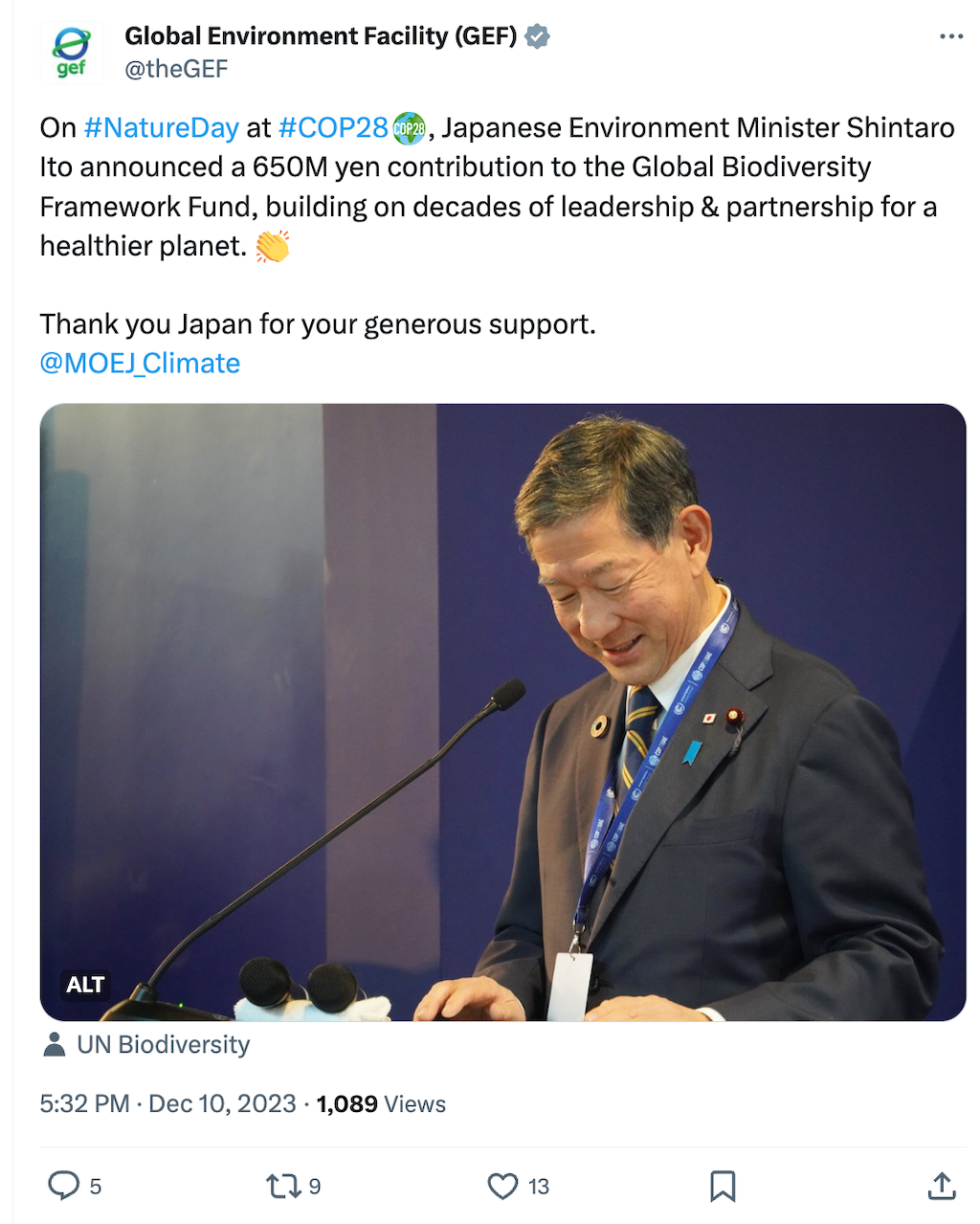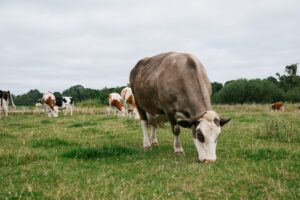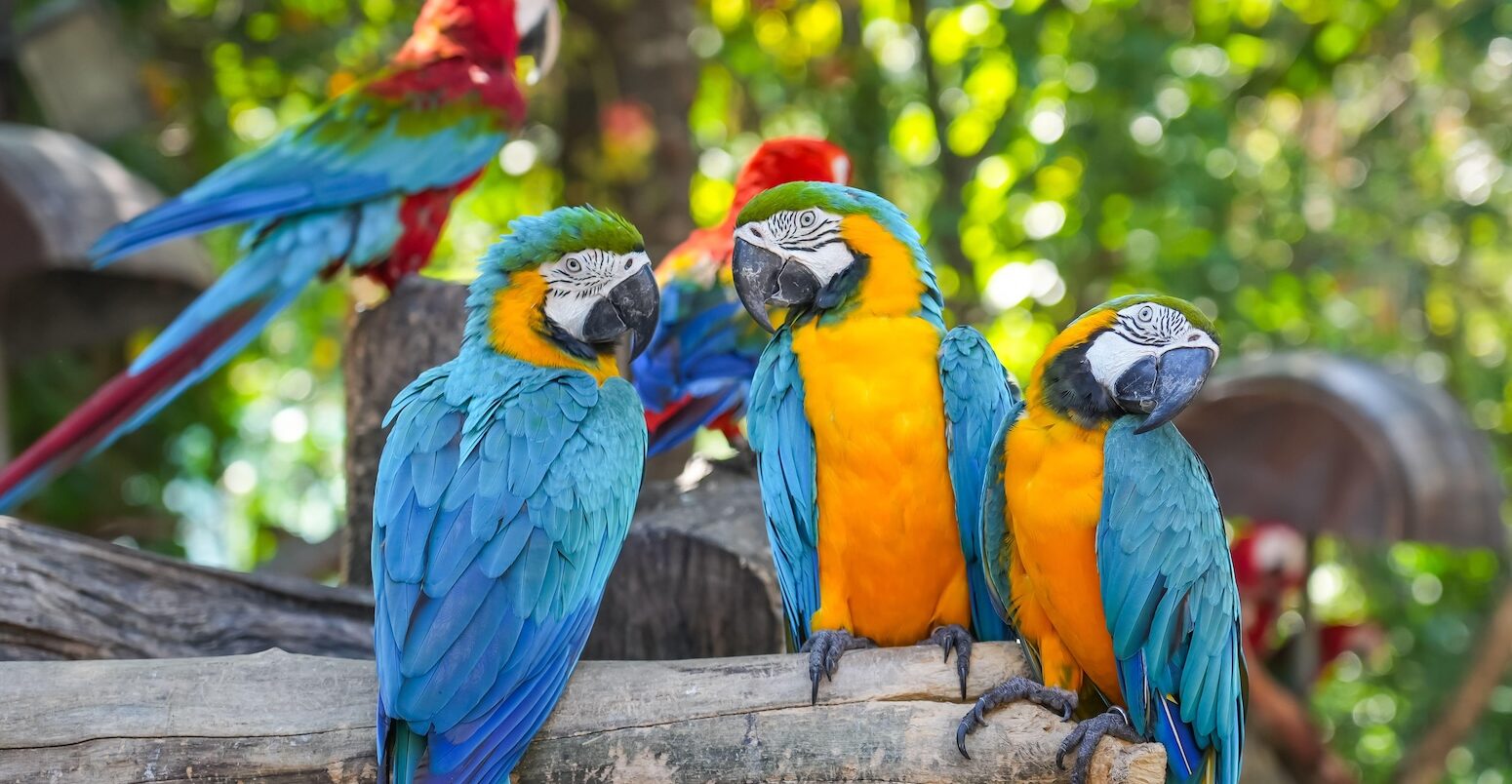
Q&A: What progress has been made on protecting nature a year on from COP15?
Multiple Authors
01.31.24It has been more than one year since the gavel came down at the last UN biodiversity summit, where almost every country in the world agreed on a plan to protect nature.
The Kunming-Montreal Global Biodiversity Framework was signed off at the COP15 summit in Montreal, Canada in December 2022. (See Carbon Brief’s in-depth summary of the key outcomes.)
The landmark deal contained a number of goals and targets for countries to achieve over the coming years – such as setting aside land for wildlife, reducing pesticide risks and restoring ecosystems.
In the months since, more nature pledges have been announced, a new biodiversity fund was established and more science showing the impacts of humans on nature has been published.
Countries will gather at the next UN biodiversity summit, due to be held in Colombia this October, to take stock of progress since the deal was given the green light and submit new national plans outlining how they will protect biodiversity.
Carbon Brief has taken an in-depth look at progress on individual nature issues and the key biodiversity updates since the COP15 summit.
- What was agreed at the UN biodiversity summit in Montreal?
- What has happened since the Global Biodiversity Framework was adopted?
- Key negotiation issues
- What do we know about the next UN biodiversity summit?
What was agreed at the UN biodiversity summit in Montreal?
The UN biodiversity summit takes place every two years, unlike the climate COP, which takes place annually.
At COP15 – the last round of biodiversity talks in Montreal in December 2022 – almost every country in the world agreed to a landmark deal to repair nature.
The Kunming-Montreal Global Biodiversity Framework (GBF) included four long-term global goals and 23 specific targets, with an overall mission of halting and reversing biodiversity loss by 2030.
Some of the key targets include conserving 30% of the world’s land and 30% of the ocean by 2030, reducing the impact of invasive species, cutting pesticides, sustainably managing agriculture and prioritising involvement of Indigenous peoples and local communities in different ways.
Alongside the overall framework, dozens of other decisions were made around the more technical aspects of the negotiations, including figuring out ways to monitor national progress and gather finance to fund action, particularly in lower-income countries.
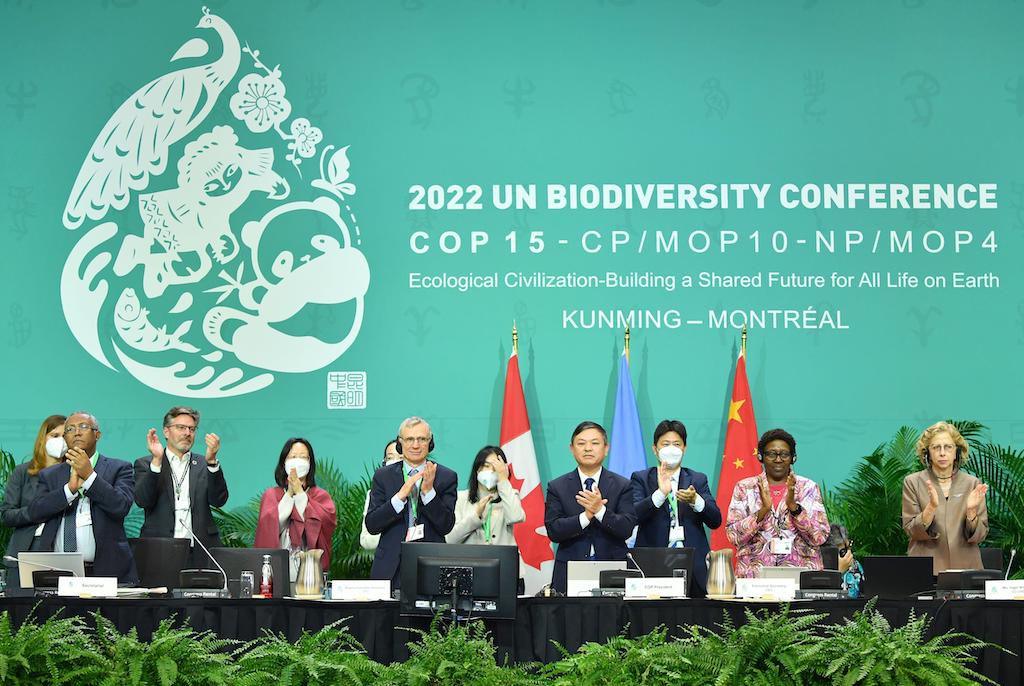
Although the agreements made at the summit are not legally binding, nations also agreed on a plan to report on, review and voluntarily increase their ambitions to tackle biodiversity loss. This is similar to the plan drawn up to implement the Paris Agreement for climate change.
A lack of implementation was widely cited as one of the major factors behind the failure of the Aichi targets, the last set of global biodiversity aims.
Although the COP15 agreement was widely seen as a success, some countries – particularly the Democratic Republic of Congo – felt frustrated and outraged at the manner in which the GBF was given the green light.
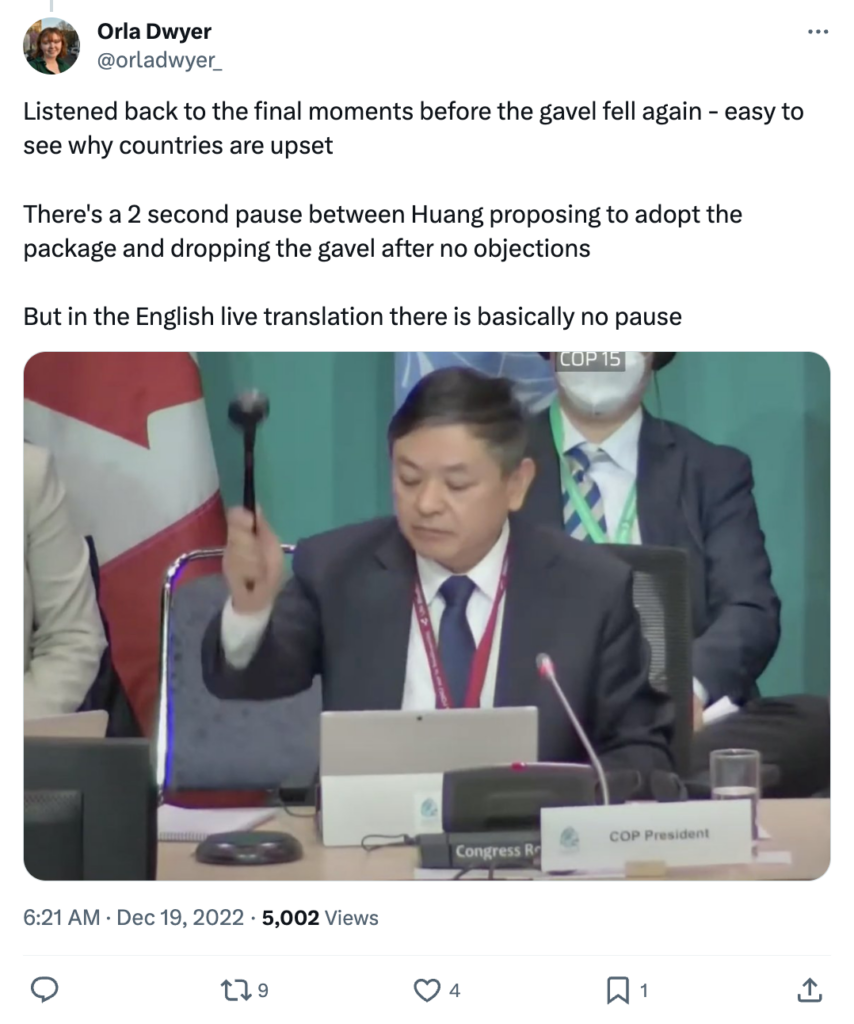
In the final stages of the summit, the deal was seen to be quickly gavelled through by summit president, Chinese environment minister Huang Runqiu, despite objections from the DRC minutes earlier in the plenary.
Following the close of the plenary, there were arguments over the manner in which the final approval happened, but all countries eventually supported the deal.

In the wake of the agreement, UN secretary general António Guterres said that “we are finally starting to forge a peace pact with nature”.
Canadian environment minister Steven Guilbeault said that the GBF is a “major win for our planet and for all of humanity”, which will chart a course “away from the relentless destruction of habitats and species”.
The International Indigenous Forum on Biodiversity welcomed the “timely recognition” of Indigenous peoples and local community contributions, roles, rights and responsibilities to nature. A statement from the group said:
“We have spoken and you have heard us, let us now put those words into action.”
What has happened since the Global Biodiversity Framework was adopted?
Several events and meetings since COP15 have addressed nature and biodiversity in different ways.
On 15 February 2023, Dr David Cooper took over from Elizabeth Maruma Mrema as the new acting executive secretary of the Convention on Biological Diversity (CBD). The CBD is an international treaty established in 1992 with the objective of conserving and sustainably using biodiversity, and ensuring the fair sharing of benefits from the use of genetic resources.
Before his appointment, Cooper had assisted the CBD secretariat as deputy executive secretary, contributing to a “successful finalisation and adoption of the Kunming-Montreal Global Biodiversity Framework”, according to the CBD. He was a lead author of three editions of the Global Biodiversity Outlook and other assessments.
Mrema was appointed deputy executive director of the UN Environment Programme.
March saw the emergence of the High Seas Treaty, a legally binding global agreement for conserving and sustainably using areas of the ocean beyond national jurisdictions – also known as the “high seas” or international waters. Carbon Brief reported that the treaty “provides the framework for establishing protected areas where previously there had not been a clear mechanism for doing so”. (For more on the high seas treaty, see: Oceans.)
The Amazon Summit, held in August last year, gathered leaders of the eight Amazon basin countries, who delivered the Belém Declaration. The document will strengthen the Amazon Cooperation Treaty Organization to prevent the rainforest “from reaching the point of no return”. The summit’s outcomes were labelled as “hopeful, but insufficient” by various civil and Indigenous organisations for having no specific targets for curbing deforestation.
In late 2023, countries from the Amazon, the Congo Basin and south-east Asia agreed to protect their rainforests and boost nature finance during the Three Basins Summit in the Republic of the Congo. However, experts told Carbon Brief at the time that the meeting failed to reach a unified alliance and was, ultimately, “underwhelming”.
October marked the official end of COP15 with a meeting in Nairobi, which served to finish off some “outstanding business in Montreal” and advance the recommendations from the Subsidiary Body on Scientific, Technical and Technological Advice (SBSTTA) on implementation and review. Delegates also issued a draft recommendation on climate change and biodiversity.
Key negotiation issues
Over the past year, there have been a number of summits, finance pledges and intergovernmental talks relating to biodiversity.
Below, Carbon Brief outlines the progress on the key biodiversity COP negotiation topics and related issues in the months since Montreal – from movement on the “30 by 30” goal to the focus on Indigenous rights.
Halting and reversing biodiversity loss
Back in Montreal, countries agreed that the overall mission of the GBF should be to “halt and reverse biodiversity loss by 2030”.
The GBF has been likened to the “Paris Agreement for nature”, with some comparing the 2030 goal of halting and reversing biodiversity loss to the aspirational 1.5C temperature limit.

After the GBF was agreed, Carbon Brief spoke to a range of biodiversity scientists who said that halting and reversing biodiversity loss by 2030 would be incredibly challenging.
A landmark report released in 2019 by the world’s biodiversity authority, the Intergovernmental Science-Policy Platform on Biodiversity and Ecosystem Services (IPBES), found that one million animal and plant species now face extinction. This is more than at any other point in human history.
Across the world, populations of mammals, birds, amphibians, reptiles and fish decreased by an average of 69% between 1970 and 2016, according to a 2022 WWF report on more than 30,000 animal populations. In tropical central and South America, the animal populations covered by the study fell by an average of 94% over this period.
Scientists also told Carbon Brief that achieving the mission would largely be decided by meeting the targets of the GBF that tackle the direct causes of biodiversity loss.
These include target 18, which addresses subsidies harmful to biodiversity; target 7, which addresses pollution; and targets 5 and 9, which address the “sustainable use” of biodiversity. (Progress on several targets is discussed in more detail below.)
One issue that negotiators have continued to work on since the GBF was agreed is developing a set of indicators for measuring biodiversity loss.
While many people associate “biodiversity” with iconic species and tropical rainforests, the term actually covers the whole spectrum of Earth’s biological diversity, ranging from the organisation of genes within organisms to the communities of animals and plants that make up ecosystems. This complexity makes biodiversity loss particularly difficult to measure.
At COP15, countries decided to set up a technical group to develop biodiversity loss indicators ahead of COP16, spearheaded by Colombia and the UK. Comprising 45 experts, the group has met several times virtually in 2023 and will meet for in-person discussions in Cambridge, England in March of this year.
30 by 30
One aim that grabbed the attention of politicians, media, activists – and even celebrities – at COP15 was the pledge to protect 30% of the world’s land and seas for nature by 2030, commonly referred to as “30 by 30”. It is contained within target 3 of the GBF.

The fight to get 30 by 30 into the GBF was spearheaded by a group of countries calling itself the High Ambition Coalition for Nature and People (HACN&P). It is led by Costa Rica and France, with the UK acting as a co-chair for the ocean component of the pledge.
Since COP15, the HACN&P set up a secretariat directed by former Costa Rican biodiversity negotiator Rita El Zaghloul.
During an interview at the COP28 climate summit in Dubai in December 2023, El Zaghloul told Carbon Brief that with the GBF agreed, the HACN&P has shifted its focus to ensuring the most vulnerable countries have the tools required to meet the target.
At COP28, she announced that the HACN&P had created a new “30 by 30 solutions toolkit” and a financial and technical “matchmaking” service. Explaining the purpose of these tools to Carbon Brief, she said:
“Because it was HACN&P that started the 30 by 30 movement, it is also our responsibility to ensure that countries have the sufficient support and tools to meet the target.
“We know that it is an ambitious target, because we have to move from approximately 17% on land and 8% on oceans [that is currently protected] to 30% on both. Many of the megadiverse countries are developing countries and small island developing states, so we need to provide them with the tools.”
Elsewhere at COP28, China surprised delegates by announcing that it was joining the HACN&P. The announcement came from COP15 president and China environment minister Huang Runqiu via videolink at a high-level session on 30 by 30.
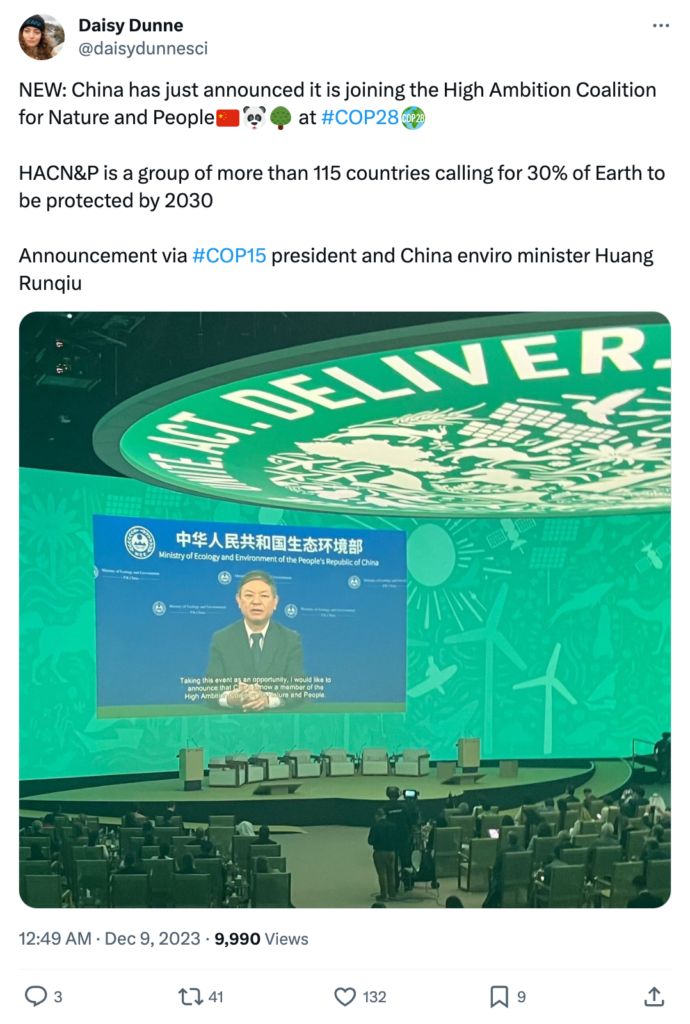
El Zaghloul told Carbon Brief that the announcement came after more than two years of talks with China, who were initially reluctant to join the initiative while still maintaining the “neutral” role of COP15 president.
As of the end of COP28 in December 2023, 118 countries had joined the HACN&P. This compares to 114 in December 2022. (There are 196 countries, including the EU, that are party to the CBD. All of these countries have committed to 30 by 30 through the GBF.)
Finance
At COP15 in Montreal, the gavel went down adopting the GBF and its finance package amid controversy and objections from biodiverse developing countries.
The final finance target seeks to mobilise “at least $200bn per year” by 2030 from “all sources” – domestic, international, public and private. For comparison, the biodiversity finance gap for conservation is estimated at roughly $700bn per year for this decade.
Developed countries – along with others that “voluntarily assume” their obligations – are expected to “substantially and progressively increase” their international finance flows for nature “to at least $20bn per year by 2025 and to at least $30bn per year by 2030”, according to the GBF’s Target 19l.
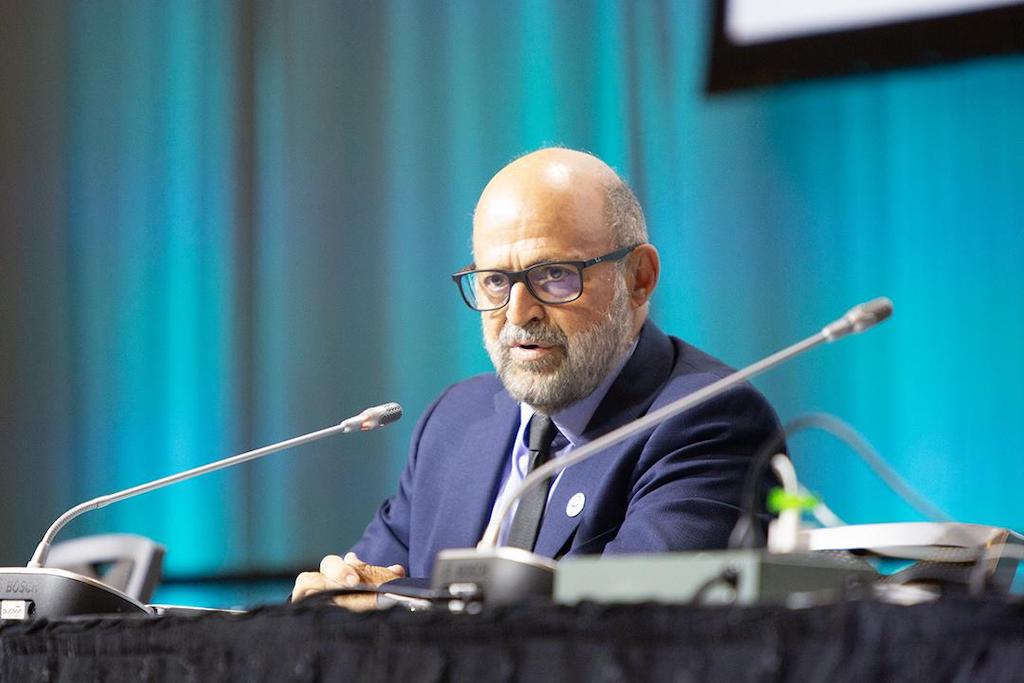
Despite calls from many developing countries for a distinct fund housed under the COP, COP15 requested the Global Environment Facility (GEF) set up a special trust fund. This would be called the “Global Biodiversity Framework Fund” (GBF Fund) and be established “in 2023, and until 2030” to receive “financing from all sources”.
On June 29 last year, the GEF’s governing board approved plans to set up this “game-changing” new fund to finance the Framework’s implementation.
The GEF’s governing board approved plans to establish the fund on 29 June last year. A month later, at the GEF assembly in Vancouver, 186 countries ratified and officially launched the GBF Fund.
At the GEF assembly, COP15 hosts Canada contributed an initial capitalisation of C$200m ($147.3m), while the UK pledged £10m ($12.6m).
As much as 20% of the funds are intended for supporting Indigenous-led initiatives to protect and conserve biodiversity.
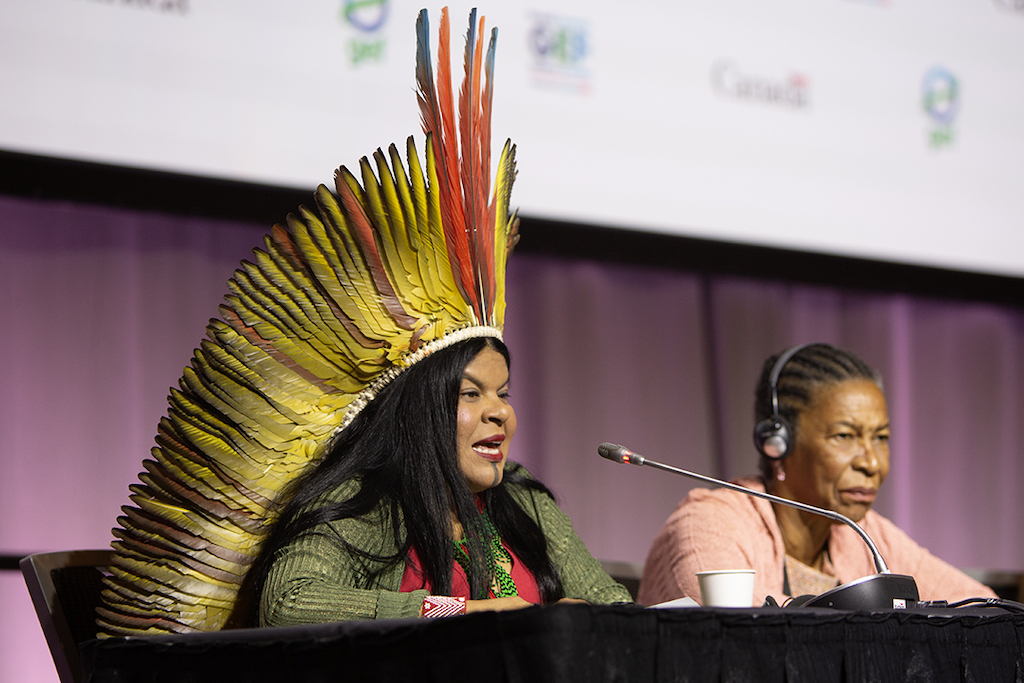
Indigenous groups – often sidelined from direct access to conservation funding – welcomed the dedicated allocation. Brazil’s Indigenous minister Sonia Guajajara pointed out that this “should not just be an aspirational criterion, but a concrete target that needs to be constantly updated” and called for “shared governance mechanisms that include recipient countries”.
Separately, at least 36% of the fund’s resources are to support small island developing states and least-developed countries.
At the assembly, Cuba and Honduras called for “simplified processes for obtaining” funding, the Earth News Bulletin reported. At the same time, the DRC, Namibia, Yemen and the Gambia “urged” more direct access to funds and minimising transaction costs.
At a side event on the sidelines of the UN general assembly in September, Germany pledged the final €40m ($43.3m) to put the fund into operation.
On Nature Day at COP28, Japan then pledged ¥650m ($43.8m). While this took the fund’s initial total capitalisation to about $247m, this falls far short of the “at least $20bn per year by 2025” target that developed countries were to raise. The US and EU, who supported and “welcomed” the fund, are yet to commit any new money.
The fund’s governing body will meet for the first time on 8 and 9 February this year in Washington DC to discuss its budget, business plan and how resources are allocated, with projects set to be funded by the end of 2024.
If approved, projects backed by all eligible countries will have to go through consecutive selection rounds for funding based on criteria, including their potential to generate global environmental benefits, alignment with the GBF’s goals and National Biodiversity Strategies and Action Plans (NBSAPs), and their ability to raise resources from the private sector.

Not all the money raised for the fund will go to funding biodiversity projects directly: it will also have to cover staff costs, travel, consultants, monitoring and independent evaluation.
Additionally, if the fund’s current budget request is approved, it will have to pay the World Bank – the GEF’s host– an indirect charge of 11% on all direct costs for administrative support – a 300% increase from last year.
The UN Environment Programme’s State of Finance for Nature 2023 report, released at COP28, found that public finance still accounts for the majority of conservation spending in the GBF’s first year. At the same time, it found that contributions from biodiversity offsets and credits grew sharply in 2022 as countries including the UK, France and Australia rolled out new nature markets.
The report also noted that philanthropy – “driven by support for 30 by 30” – and private finance mobilised by debt instruments such as blue bonds and rhino bonds grew last year as well. But, it added, these small numbers paled in comparison with $7tn in nature-negative investments made the same year.
Implementation
Ensuring that the targets contained within the GBF are actually implemented by countries will be the major challenge in the coming years, experts tell Carbon Brief.
Details for how the agreement should be implemented – the so-called “teeth” of the deal – are contained within Section J of the GBF itself and a separate document called “mechanisms for planning, monitoring, reporting and review”. (It is worth noting that the GBF and its underlying documents are not legally binding.)
The agreed plan for how the GBF should be implemented by countries follows three key steps – sometimes referred to as “present, review and ratchet”. This closely mirrors the implementation schedule of the Paris Agreement.
Section J of the GBF specifies that countries should present national biodiversity strategies and action plans, or “NBSAPs”, that are “in alignment” with the GBF and its goals and targets. The underlying document adds that this should be done “by COP16”.
Since the end of COP15, France, the EU, Luxembourg, Hungary, Japan and Spain have submitted updated NBSAPs. The UK has indicated it will release its new NBSAP in May of this year.
In September 2023, an “accelerator partnership” to “fast-track and upscale” new NBSAPs was officially launched at New York Climate Week, after first being agreed at COP15. The initiative is headed by Colombia and Germany, with the support of various UN bodies.
As for the “review” step, countries have agreed to conduct a global analysis of whether NBSAPs align with the GBF at COP16 and hold a “global review” of progress at COP17 and COP19.
After this, countries “may take the outcome of the global reviews into account in future revisions and implementation of their” NBSAPs. This is the “ratchet” element of the implementation mechanism.
In October 2023, negotiators met in Nairobi to officially close COP15. The aim of this meeting was to tie up loose ends remaining from the landmark agreement of the GBF in Montreal in 2022.
The event brought together scientific and technical experts to give advice on what should be included in the global review earmarked for COP17 in 2026. Bernadette Fischler Hooper, the head of global advocacy at WWF International, told Carbon Brief:
“The technical experts and scientific experts discussed what should be in this report. So it was very focused on what that report should contain.”
Nature-based solutions
The use of nature to mitigate and adapt to climate change – known as nature-based solutions – featured a number of times in the GBF’s targets.
At COP28 in Dubai, nature-based solutions were also discussed at different stages. The global stocktake text – a key outcome of the summit that showed how countries can increase action to meet climate goals – “encourages” the implementation of nature-based solutions.

A report released in June by the International Institute for Sustainable Development recommended ways to ensure that nature-based solutions will boost biodiversity and ecosystems.
In a list of draft recommendations from the final round of intergovernmental talks on nature-based solutions, the co-chairs suggested ways to support their use.
These include setting up a database of policies related to nature-based solutions to enable learning between countries, analysing the technical tools available to support implementing such solutions and making a how-to guide for accessing finance for these projects.
At COP28, more than 150 companies and financial institutions said they would increase investments in nature-based solutions.
At COP16, nature-based solutions will likely feature in many national biodiversity action plans and will continue to be one of the key talking points, experts tell Carbon Brief.
For example, Spain intends to prioritise a number of different areas including nature-based solutions over the next few years to meet its climate and biodiversity targets, according to its revised NBSAP.
Invasive species
Invasive alien species are animals, plants or other organisms that have spread into places outside their natural habitats. These can negatively impact both nature and people, according to IPBES.
Target 6 of the GBF aims to reduce the establishment and introduction of invasive alien species by 50% by 2030.

Since the GBF was agreed at COP15, there have been advances in the knowledge of the distribution of invasive species across the world and the ways countries can handle biological invasions.
In September last year, IPBES published an assessment report on invasive alien species, which notes that humans have introduced 37,000 invasive alien species.
The report, based on more than 13,000 scientific studies, says that despite this, more than 80% of countries lack national legislation or regulations to address invasive species. However, it outlines three frameworks for governments to manage biological invasions, from introduction pathway management to species-based and site-based management. (For more, read Carbon Brief’s coverage of the IPBES report.)
According to reporting by the Earth Negotiations Bulletin (ENB), the CBD’s SBSTTA Nairobi meeting in October emphasised the need to develop strategies to simultaneously address two main causes of biodiversity loss – climate change and invasive alien species – and to step up collaboration among environmental agreements to implement the GBF.
It also reported that the SBSTTA adopted eight resolutions, including one on invasive alien species. Among other things, such a resolution addresses how to identify and minimise cross-border e-commerce of live organisms or manage invasive alien species by preventing risks from climate change.
The secretariat of the CBD issued a document providing draft voluntary guidance and advice on matters regarding invasive alien species. These guidelines included the best methodologies for managing invasive alien species, such as cost-benefit, cost-effectiveness and multicriteria analysis.
The SBSTTA recommended the use of the IPBES report on invasive species for implementing the GBF, the CBD and NBSAPs. It also called on COP16 to acknowledge the importance of enhancing information availability and accessibility to strengthen the management of invasive species, according to the ENB.
The full IPBES assessment on invasive species could be approved at COP16, ENB reported.
Links between climate and biodiversity
Several experts tell Carbon Brief that there was a marked increase in the attention paid to biodiversity and nature at the UN climate summit, COP28, compared to previous editions.
An event hosted during the summit’s thematic “nature” day saw the hosts of COP28 and COP15 – the United Arab Emirates and China, respectively – announce a Joint Statement on Climate, Nature and People.
The statement included a pledge by its signatories to work towards “comprehensiveness and cohesion” between countries’ national climate policies (“nationally determined contributions” or “NDCs”) and their national plans for nature (“national biodiversity strategies and action plans” or “NBSAPs”). Dr David Cooper, CBD acting executive secretary, says the statement was “very welcome”. He tells Carbon Brief:
“Countries have to now, in the light of the Kunming-Montreal [Global] Biodiversity Framework, develop their national targets and include them in their national biodiversity strategies and action plans, and they are currently doing that.
“It’s clear that in light of the stocktake [at COP28] NDCs will have to be ramped up. So that’s a big opportunity to make sure that the role of nature, the role of biodiversity [and] ecosystems is fully used in that…The need to protect those sinks and so on is also an additional motivation for strengthening the ambition of the NDCs.”
Pepe Clarke, global oceans practice lead at WWF-International, tells Carbon Brief:
“We’re continuing to see closer integration of biodiversity considerations into global climate negotiations, which is a really positive and continuing trend.”
Indigenous rights
According to the International Indigenous Forum on Biodiversity (IIFB), Indigenous rights figure in seven of the GBF’s targets, including spatial planning, area-based conservation, sustainable use and participation and respect for the rights of Indigenous peoples and local communities.
For example, Target 22 aims to ensure the participation of Indigenous peoples and local communities in decision-making and the respect of their rights over their lands and territories.

After the framework was agreed, the IIFB welcomed such recognition and said it would collaborate to implement the GBF and apply the “monitoring and reporting framework through community-based monitoring”.
In a meeting convened in November 2023, delegates reviewed the work programme for the section of the CBD that aims to respect and preserve Indigenous peoples’ knowledge and practices. They will continue these discussions at COP16.
The working group also looked at creating a permanent subsidiary body to offer advice to the COP and to enhance the participation of Indigenous peoples and local communities in other subsidiary bodies of the CBD.
In a comment piece, WWF’s head of policy research and development, Guido Broekhoven, said one of the goals of the GBF Fund (GBFF), created in August 2023, is elevating funding for conservation actions undertaken by Indigenous peoples.
Up to 20% of the funds are intended for supporting Indigenous-led initiatives to protect and conserve biodiversity. The first instalment of the GBFF is expected to be delivered before COP16, Down to Earth reported.
Lucy Mulenkei, co-chair of the IIFB, said in a press release that “the creation of this fund and its commitment to supporting Indigenous Peoples and local communities is an important and clear recognition of the fundamental role they have had for generations [in] protecting biodiversity”.
However, Broekhoven noted in his comment piece that there needs to be more climate finance directly reaching communities protecting ecosystems, such as the Amazon and the Congo rainforest. He said that doing so “is critical to encouraging all countries to announce ambitious NBSAPs ahead of COP16 and to keeping the goal of halting and reversing biodiversity loss by 2030 in sight”.
Oceans
In the year since COP15, the world has moved forward on several marine-related treaties and policies, including the High Seas Treaty, an agreement on fishery subsidies at the World Trade Organization (see: harmful subsidies) and a global treaty on plastic pollution. In addition, debates around deep-sea mining have continued at both the national and international levels.
Officially finalised in June, the High Seas Treaty – a legally binding framework governing the use and conservation of international waters – has garnered more than 80 signatures since it opened for countries to sign at the UN general assembly in September. Dr Rachel Tiller, a chief scientist at Norway’s SINTEF Ocean, tells Carbon Brief:
“The path of getting a treaty up and standing and walking, is that first you have to sign it. And that doesn’t mean anything else other than that you intend not to in any way hinder its continued life…You’ve only said that ‘we have an intention of continuing this process and we intend to be part of it’.”
On 22 January, Palau became the first country to ratify the treaty. In total, 60 countries must do so before the treaty can come into effect. During this time, Clarke says, technical preparatory work can be done, but no formal work under the treaty body can be undertaken.
Tiller adds:
“What I worry, and what some others worry, about is now it’s going to be a race to do everything before they ratify – that everybody wants to do whatever they need to do before there’s some kind of legal agreement stopping them or hindering them in some way.”
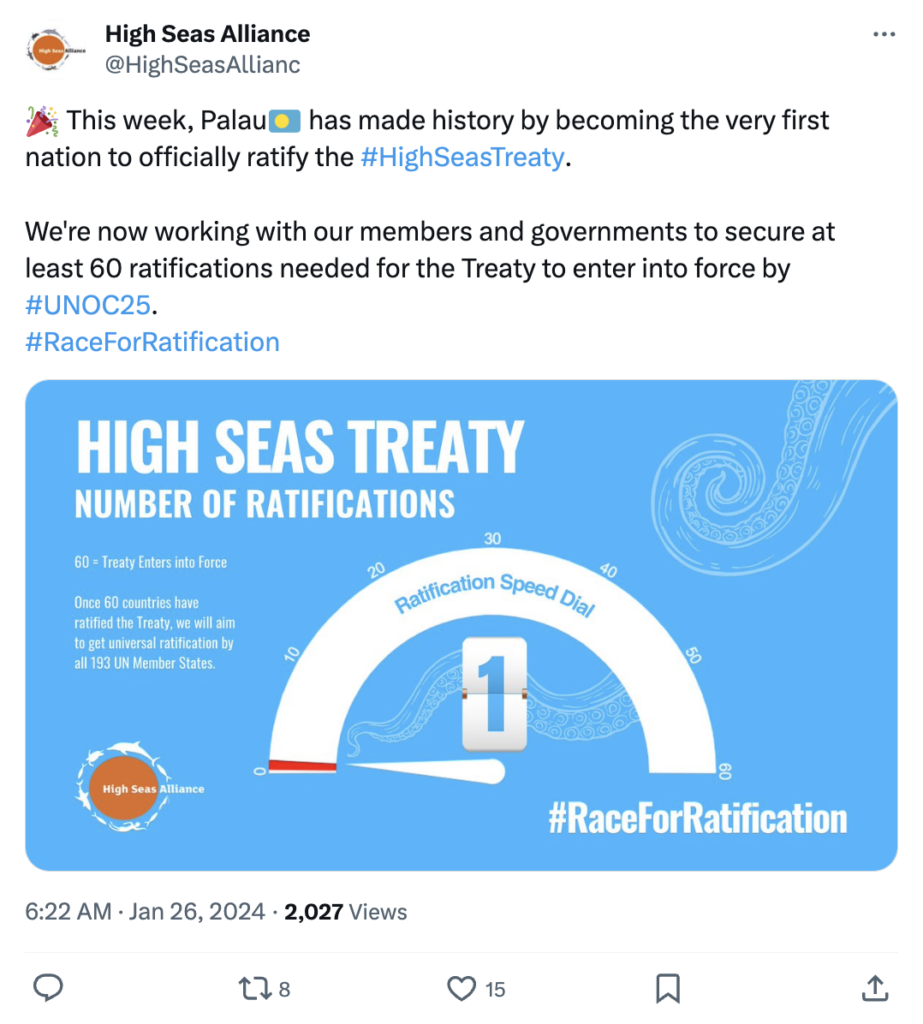
While Norway recently approved seabed mining in its territorial waters in the Arctic Ocean, debates around such mining in international waters have continued at the International Seabed Authority. There is a “steadily growing number of countries that are coming off the fence” to support a moratorium, or a precautionary pause, on seabed mining, Clarke tells Carbon Brief.
If a pause took effect, Clarke says, “there would also need to be a significant body of work done on the scientific and technical side of things, to better understand the risks associated with seabed mining”. But it is unlikely that an agreement will be reached this year, he adds.
Overall, Clarke tells Carbon Brief:
“There has been quite significant forward progress in terms of the foundational architecture of agreements and government commitments needed to take forward key elements of the ocean policy agenda…[But] we’ve not seen the step change, particularly in protection, that we’re going to need to deliver the GBF in full by 2030.”
Digital sequence information
A new global mechanism and fund for sharing benefits from digital sequence information (DSI) was hailed by many as one of the big wins that clinched the deal at COP15. Digital sequence information refers to data derived from genetic resources, which is often sourced from biodiverse regions and communities who may not always benefit from its publication or use.
The COP decision on DSI established an ad hoc open-ended working group to finesse much of the crucial fine print that remains before COP16.
The group held its first meeting in Geneva in November 2023, where it identified five sets of core questions on how the fund is governed, who contributes to it, who benefits, what “non-monetary benefits” should look like and how the mechanism could work with existing national and other multilateral approaches to benefit-sharing.
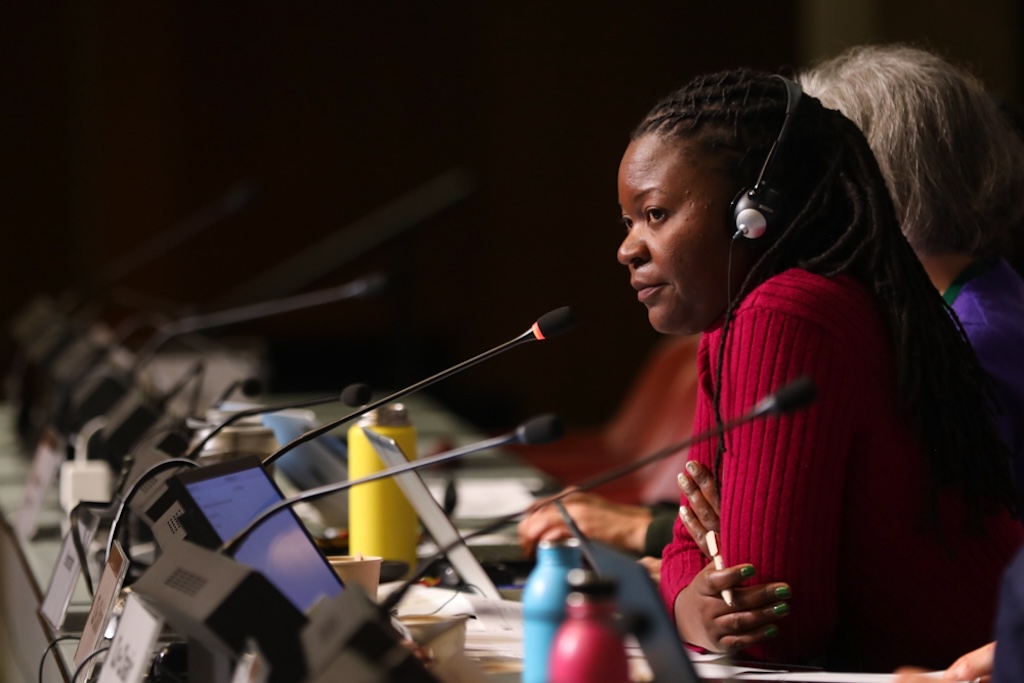
According to the meeting report, countries agreed that the fund should contribute to achieving the GBF’s finance target and closing the $700bn biodiversity finance gap, with the COP deciding strategic funding priorities.
Developing and developed countries differed on several subjects, such as legally binding obligations on donors versus voluntary contributions and potential sources of funding, such as profit-sharing or a 1% retail levy on products derived from DSI. Another unresolved issue is how to distribute these benefits: by country allocation, on a project basis or something else.
Japan, Switzerland and the US – which is not party to the CBD – stressed “solely voluntary” contributions to the fund in their submissions, claiming this would be simple and easy to implement quickly.
Countries came together in favour of elements around capacity-building and the fund being used to meet biodiversity-related Sustainable Development Goals and the self-identified needs of Indigenous peoples and local communities..
Brazil, India, Argentina, Indonesia and the African Group maintained that non-monetary benefit sharing should go beyond just capacity building on how to use DSI and could include collaborative research.
According to Third World Network, “a very controversial question” that remains is whether funding allocations should be based, at least partially, on the geographical origins of genetic material.
In its closing plenary on 18 November, the working group adopted a final outcome on possible elements for the mechanism and fund.
But with much of the work still unfinished, they constituted an Informal Advisory Group to carry on intersessional work until the group’s second meeting in August 2024. That group convened online for the first time on 23 January to discuss data governance and DSI databases and is scheduled to meet five more times before August.
DSI developments under the CBD are being closely monitored for coherence with other treaty bodies and access-and-benefit sharing mechanisms, particularly the High Seas Treaty, the International Treaty on Plant Genetic Resources for Food and Agriculture (ITPGRFA) and the World Health Organization’s pandemic preparedness framework.
Amid these ongoing negotiations, groups such as the DSI Scientific Network are calling for all current benefit-sharing mechanisms to be “harmonised” and saying that they should not “hinder” or “undermine” science.
Dr Siva Thambisetty, an intellectual property expert at the London School of Economics and an advisor to the G77+China bloc, tells Carbon Brief that the group’s viewpoint that “biology does not respect UN legal boundaries” is “catchy, but there is nothing natural about DSI use, circulation and storage – the consequences of which are closely connected to infrastructure, power and choice.”
Thambisetty adds that the GBF “must not sideline consensually-formed gains on benefit-sharing” under the High Seas Treaty but, instead, follow its lead.
Harmful subsidies
At COP15, countries agreed to identify – by 2025 – and then “eliminate, phase out or reform incentives, including subsidies” that are harmful for biodiversity.
The agreement also said that these incentives should be “substantially and progressively” reduced by at least $500bn each year by 2030, “starting with the most harmful incentives”.
Harmful subsidies were discussed at the COP28 climate summit in Dubai, particularly around fossil fuels.
The global stocktake text calls for the phasing out of “inefficient…subsidies that do not address energy poverty or just transitions, as soon as possible”. (For more on how countries plan to reduce biodiversity harmful subsidies, read Carbon Brief’s Q&A.)
The UN Development Programme recently published a report outlining a “step-by-step” guide to redirecting biodiversity harmful subsidies.
A World Bank report, published in June last year, said that explicit and implicit subsidies for fossil fuels, agriculture and fisheries now exceed $7tn each year. They are “harming people, the planet and economies”, the report said.
Early last year, the UK made moves away from harmful farming subsidies through its new funding scheme for farms in England, which is intended to replace the payments from the EU’s Common Agricultural Policy. The UK’s funding scheme was updated with more funding and incentives in recent weeks.
Over the past few months, German farmers have been protesting against government plans to phase out and cut some agricultural subsidies and tax breaks.

In other subsidy developments, the UK and the Gambia were among the countries to recently accept the World Trade Organization (WTO) agreement on setting new rules to curb fishing-related subsidies.
The deal – agreed in 2022 – has now been accepted by 55 WTO members, which brings it halfway to the 110 needed for it to take effect.
It might “reach the necessary threshold over the next year or so” as subsidy negotiations continue, according to WWF’s Clarke.
These talks are ongoing and a draft text on curbing subsidies that add to overcapacity and overfishing will be discussed at a WTO ministerial conference in Abu Dhabi in February. Clarke tells Carbon Brief that the fishery negotiations are “complex”, adding:
“Colleagues who have now been engaging with this technical negotiation track have really expressed to me how concerned they are about the fact that this seems to be entering into a traditional trade negotiation, where each country is seeking to advance its own interests rather than deal with a common challenge.”
What do we know about the next UN biodiversity summit?
The next biodiversity summit, COP16, will take place in Colombia from 21 October to 1 November 2024. Six cities have offered to host, but the exact location has yet to be decided, according to the CBD.
Turkey withdrew as host last July after being hit by three earthquakes earlier in the year that killed more than 50,000 people and displaced millions.
It is understood that the CBD was in talks with a number of countries in Europe and South America in recent months until Colombia’s offer was announced at COP28 in December 2023.
The country plans to move away from fossil fuels under its current leftwing government, but still relies heavily on oil production revenue.
CBD acting executive secretary Cooper says it is “exciting” for the conference to take place in a “mega-diverse country” with “very strong Indigenous peoples’ organisations [and] a very strong scientific base”.
He adds that the Colombian environment minister, Susana Muhamed, is a “very inspiring leader” who could boost political will and “momentum in implementing the GBF”.
Muhamad has said that the slogan of COP16 will be “peace for nature”.
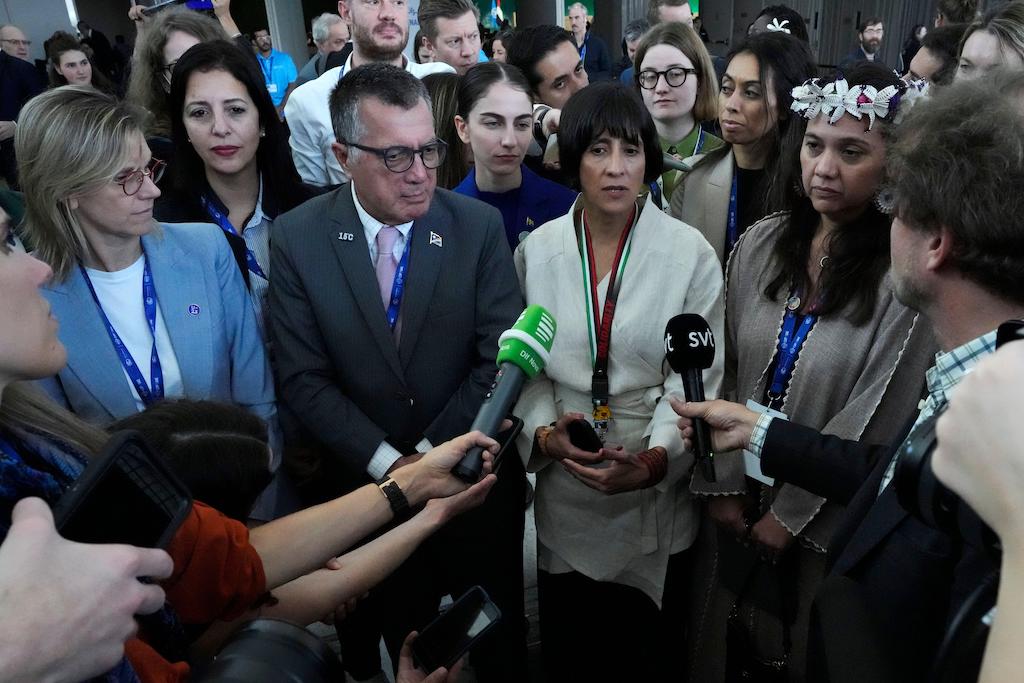
Other environment ministers from around the world will attend COP16, but presidents and prime ministers are generally not invited to the UN biodiversity summits. Cooper says that there are currently no plans to invite them to Colombia either. He tells Carbon Brief:
“It is important, though, that leaders are fully engaged. We will only achieve the goals and targets of the Kunming framework through a whole government approach.”
Cooper says he wants to see nations to “come with a strong commitment and strong actions already in place”. He notes:
“The first important function of COP16 is to put the spotlight on countries in terms of what has been achieved, what is being achieved, what hasn’t been achieved and needs to be achieved.”
Ahead of COP16, countries need to submit updated national biodiversity strategies and action plans that better align with the Kunming-Montreal deal (See: Implementation).
China, France, Japan, Hungary, the EU and others have already submitted their plans.
Other issues due to be finalised at COP16 include the monitoring framework for the GBF and a strategy for financial resource mobilisation. Talks on digital sequence information are also due to wrap up, and Cooper says that he wants to see “very clear progress” towards 2025 financial goals.
Another expected announcement is a global plan of action on the ties between health and biodiversity.

Over the course of 2024, meetings of different groups focused on indicators, risk assessment, benefit sharing and implementation will take place. Key SBSTTA and implementation subsidiary body meetings will happen in Nairobi in May.
In addition, 2024 is a major election year for dozens of countries around the world – including biodiverse superpowers India, Indonesia, Mexico and Brazil. The DRC also held a presidential vote late last year.
Cooper says that while nature is “less of a political football than climate change”, there is always a risk of “populist politicians or vested interests trying to drive a wedge” between sectors – especially agriculture and biodiversity conservation. He tells Carbon Brief:
“We have to make the case and really try and prevent these communities from being driven apart.”
Road to COP16
| 22-26 Jan | Conference on cooperation among the biodiversity-related conventions for implementation of the GBF | Bern |
| 5-9 Feb | Meeting of the GEF Council | Washington DC |
| 26-29 Feb | World Trade Organization ministerial meeting | Abu Dhabi |
| 26 Feb-1 Mar | UN Environment Assembly | Nairobi |
| 18-29 Mar | 29th session of the International Seabed Authority, Part I | Kingston |
| 10-12 Apr | UN Ocean Decade conference | Barcelona, Spain |
| 23-29 Apr | Intergovernmental Negotiating Committee on plastic pollution | Ottawa |
| 13-18 May | CBD Subsidiary Body on Scientific, Technical and Technological Advice | Nairobi |
| 21-29 May | CBD Subsidiary Body on Implementation | Nairobi |
| 17-21 Jun | Meeting of the GEF Council | Washington DC |
| 15 Jul-2 Aug | 29th session of the International Seabed Authority, Part II | Kingston |
| 12-16 Aug | Meeting of the open-ended working group on digital sequencing information | Montreal |
| 10-24 Sep | UN general assembly | New York |
| 16-18 Oct | CBD Subsidiary Body on Implementation | - |
| 21 Oct-1 Nov | CBD COP16 | Colombia |
-
Q&A: What progress has been made on protecting nature a year on from COP15?



